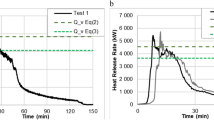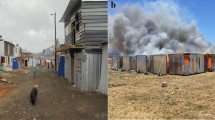Abstract
There is an increasing desire to use more engineered timber products in buildings, due to the perceived aesthetics of timber and desire for more sustainable architecture. However, there are concerns about fire performance of these products especially in taller buildings. This has led to renewed research to understand the behaviour of timber surfaces in compartments exposed to fire. This paper describes a two-zone calculation model for determining the fire environment within a compartment constructed from timber products where varying amounts of timber are exposed on the walls and ceiling. A set of eight full-scale compartment experiments previously reported in the literature are used to assess the capability of the model. The fire load energy density in the experiments ranged from 92 MJ/m2 to 366 MJ/m2 comprising either wood cribs or bedroom furniture with the largest compartment having dimensions 4.5 × 3.5 × 2.5 m high with an opening 1.069 m wide × 2.0 m high. The experiments were ventilation-controlled. It is shown that the model can be used to provide conservative predictions of the fire temperatures for compartments with timber exposed on the walls and/or ceiling as part of an engineering analysis. There are several limitations that are discussed including the need to consider the debonding of layers in the case of cross-laminated timber. It is recommended that further benchmarking of the model be done for different ventilation conditions and with engineered timber products where debonding does not occur. This will test the model under a wider range of conditions than examined in this paper.















Similar content being viewed by others
References
Barber D (2015) Tall timber buildings—what’s next in fire safety? Fire Technol 51:1279–1284. https://doi.org/10.1007/s10694-015-0497-7
Barber D, Crielaard R, Li X (2016) Towards fire safety design of exposed timber in tall timber buildings. In: Proceedings of WCTE 2016 world conference on timber engineering. Vienna
FP Innovations and Binational Softwood and Lumber Council (2013) CLT handbook, US edn. FP Innovations, Pointe Claire
Harmathy TZ (1983) Fire severity: basis of fire safety design. Special Publication SP-80-3. American Concrete Institute, Indianapolis
Magnusson SE, Thelandersson S (1970) Temperature–time curves for the complete process of fire development—a theoretical study of wood fuels in enclosed spaces. The Royal Swedish Academy of Engineering Sciences, Stockholm
CEN (2002) Eurocode 1: actions on structures—part 1–2: general actions—actions on structures exposed to fire, annex A. European Committee for Standardization, Brussels
Frangi A, Fontana M (2005) Fire performance of timber structures under natural fire conditions. In: Fire safety science—proceedings of the eighth international symposium. Beijing, China, pp 279–290
Hakkarainen T (2002) Post-flashover fires in light and heavy timber construction compartments. J Fire Sci 20:133–175. https://doi.org/10.1177/0734904102020002074
McGregor C. (2013) Contribution of cross laminated timber panels to room fires. Master of Applied Science Thesis, Carleton University
Li X, Zhang X, Hadjisophocleous G, McGregor C (2015) Experimental study of combustible and non-combustible construction in a natural fire. Fire Technol 51:1447–1474. https://doi.org/10.1007/s10694-014-0407-4
Li X, McGregor C, Medina A, et al (2016) Real-scale fire tests on timber constructions. In: Proceedings of WCTE 2016 world conference on timber engineering. Vienna
Medina A (2014) Fire resistance of partially protected cross-laminated timber rooms. Master of Engineering Thesis, Carleton University
Frangi A, Fontana M, Hugi E, Jübstl R (2009) Experimental analysis of cross-laminated timber panels in fire. Fire Saf J 44:1078–1087. https://doi.org/10.1016/j.firesaf.2009.07.007
Frangi A, Fontana M, Knobloch M, Bochicchio G (2008) Fire behaviour of cross-laminated solid timber panels. In: Fire safety science—proceedings of the ninth international symposium. pp 1279–1290
Craft S (2008) Development of small-scale evaluation methods for wood adhesives at elevated temperature. FP Innovations - Forintek Division, Ottawa
Crielaard R (2015) Self-extinguishment of cross-laminated timber. Master of Science in Civil Engineering, Delft University of Technology, Delft
Hadden RM, Bartlett AI, Hidalgo JP et al (2017) Effects of exposed cross laminated timber on compartment fire dynamics. Fire Saf J 91:480–489. https://doi.org/10.1016/j.firesaf.2017.03.074
Emberley R, Putynska CG, Bolanos A et al (2017) Description of small and large-scale cross laminated timber fire tests. Fire Saf J 91:327–335. https://doi.org/10.1016/j.firesaf.2017.03.024
Bartlett AI, Hadden RM, Bisby L, Lane B (2016) Auto-extinction of engineered timber as a design methodology. In: Proceedings of WCTE 2016 world conference on timber engineering. Vienna
Su J, Lougheed GD (2014) Fire safety summary: fire research conducted for the project on midrise wood construction (report to research consortium for wood and wood-hybrid mid-rise buildings). National Research Council of Canada, Ottawa
Hadjisophocleous GV, Fu Z (2005) Development and case study of a risk assessment model CUrisk for building fires. In: Fire safety science—proceedings of the eighth international symposium. Beijing, China, pp 877–887
Zhang X, Li X, Hadjisophocleous G (2015) A design fire model for the full process of fire. In: Proceedings of the international fire safety symposium 2015, Coimbra, pp 381–390
CEN (2004) Eurocode 5: design of timber structures. Part 1–2: general—structural fire design. European Committee for Standardization, Brussels
Wade CA, Baker GB, Frank K et al (2016) B-RISK 2016 user guide and technical manual. Study report SR364. BRANZ, Porirua
Peacock RD, Jones WW, Reneke PA, Forney GP (2005) CFAST—consolidated model of fire growth and smoke transport (version 6) user’s guide. NIST Special Publication 1019, 6th edn. National Institute of Standards and Technology, Washington
Cooper LY, Forney GP (1990) The consolidated compartment fire model (CCFM) computer code application CCFM.VENTS—part I: physical basis. NISTIR 4342. National Institute of Standards and Technology, Gaithersburg
Cooper LY, Forney GP (1990) The consolidated compartment fire model (CCFM) computer code application CCFM.VENTS—part III: catalog of algorithms and subroutines. NISTIR 4344. National Institute of Standards and Technology, Gaithersburg
Utiskul Y (2007) Theoretical and experimental study on fully-developed compartment fires. PhD Thesis, University of Maryland
ISO (2006) ISO 16734 fire safety engineering—requirements governing algebraic equations—fire plumes. International Organization for Standardization, Geneva
McCaffrey BJ (1983) Momentum implications for buoyant diffusion flames. Combust Flame 52:149–167
Forney GP (1994) Computing radiative heat transfer occurring in a zone model. Fire Sci Technol 14:31–47
Hurley M, Gottuk DT, Hall JR, et al (2015) SFPE handbook of fire protection engineering, appendix 3: fuel properties and combustion data, 5th edn. Springer New York
33. Tewarson A, Jiang FH, Morikawa T (1993) Ventilation controlled combustion of polymers. Combust Flame 95:151–169
Incropera FP, DeWitt DP (1990) Fundamentals of heat and mass transfer. Wiley, New York
McCaffrey B, Quintiere JG, Harkleroad M (1981) Estimating room temperatures and the likelihood of flashover using fire data correlations. Fire Technol 17:98–119. https://doi.org/10.1007/bf02479583
Babrauskas V (2016) Heat release rates. In: Hurley MJ et al (eds) SFPE handbook of fire protection engineering, 5th edn. Springer, New York
Pitts WM (1994) The global equivalence ratio concept and the prediction of carbon monoxide formation in enclosure fires. NIST monograph 179. National Institute of Standards and Technology, Gaithersburg
Transmetra (1999) Table of emissivity of various surfaces for infrared thermometry. http://www.transmetra.ch. Accessed 25 July 2017
Nordic Wood Structures (2013) Technical Data - Nordic X-Lam. http://nordic.ca/data/files/datasheet/file/T-S22_eTechnicalData.pdf. Accessed 4 July 2017
Tran H (1992) Experimental data on wood materials. In: Babrauskas V and Grayson SJ (eds) Heat release in fires. Elsevier Applied Science, London, pp 357–372
U.S. Nuclear Regulatory Commission, Office of Nuclear Regulatory Research, Rockville, MD (RES), Electric Power Research Institute (EPRI), Palo Alto, CA (2007) Verification and validation of selected fire models for nuclear power plant applications. Volume 2: experimental uncertainty
White R (2016) Analytical methods for determining fire resistance of timber members. In: Hurley MJ et al (eds) SFPE handbook of fire protection engineering, 5th edn. Springer, New York
Acknowledgements
The authors acknowledge the financial support from the Building Research Association of New Zealand (BRANZ) Building Research Levy and Fire and Emergency New Zealand towards the research described in this paper. The B-RISK fire model described here is freely available for download from the BRANZ website.
Author information
Authors and Affiliations
Corresponding author
Rights and permissions
About this article
Cite this article
Wade, C., Spearpoint, M., Fleischmann, C. et al. Predicting the Fire Dynamics of Exposed Timber Surfaces in Compartments Using a Two-Zone Model. Fire Technol 54, 893–920 (2018). https://doi.org/10.1007/s10694-018-0714-2
Received:
Accepted:
Published:
Issue Date:
DOI: https://doi.org/10.1007/s10694-018-0714-2




